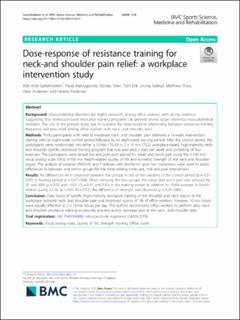| dc.contributor.author | Sæterbakken, Atle Hole | |
| dc.contributor.author | Makrygiannis, Paula | |
| dc.contributor.author | Stien, Nicolay | |
| dc.contributor.author | Solstad, Tom Erik Jorung | |
| dc.contributor.author | Shaw, Matthew Peter | |
| dc.contributor.author | Andersen, Vidar | |
| dc.contributor.author | Pedersen, Helene | |
| dc.date.accessioned | 2020-12-10T14:14:31Z | |
| dc.date.available | 2020-12-10T14:14:31Z | |
| dc.date.created | 2020-07-29T12:18:25Z | |
| dc.date.issued | 2020 | |
| dc.identifier.citation | Sæterbakken, A. H., Makrygiannis, P., Stien, N., Solstad, T. E. J., Shaw, M., Andersen, V., & Pedersen, H. (2020). Dose-response of resistance training for neck-and shoulder pain relief: A workplace intervention study. BMC Sports Science, Medicine and Rehabilitation, 12(1) | en_US |
| dc.identifier.issn | 2052-1847 | |
| dc.identifier.uri | https://hdl.handle.net/11250/2716980 | |
| dc.description.abstract | Background
Musculoskeletal disorders are highly prevalent among office workers, with strong evidence suggesting that workplace-based resistance training programs can prevent several upper extremity musculoskeletal disorders. The aim of the present study was to examine the dose-response relationship between resistance training frequency and pain relief among office workers with neck- and shoulder pain.
Methods
Thirty participants with mild to moderate neck- and shoulder pain attended a 16-week intervention starting with an eight-week control period followed by an eight-week training period. After the control period, the participants were randomized into either a 10 min (TG10) or 2 × 10 min (TG2) workplace-based, high-intensity neck- and shoulder specific resistance training program that was executed 5 days per week and consisting of four exercises. The participants were tested pre and post each period for mean and worst pain using the 0-100 mm visual analog scale (VAS), 0-100 mm health-related quality of life and isometric strength of the neck-and shoulder region. The analysis of variance (ANOVA) and Friedman with Bonferroni post hoc corrections were used to assess differences in between and within groups for the three testing times pre, mid and post intervention.
Results
No differences were observed between the groups in any of the variables in the control period (p = 0.27–0.97) or training period (p = 0.37–0.68). When merging the two groups, the mean and worst pain was reduced by 25 and 43% (p = 0.05 and < 0.01, ES = 0.41 and 0.55) in the training period in addition to 10.6% increase in health-related quality of life (p = 0.01, ES = 0.52). No difference in strength was observed (p = 0.29–0.85).
Conclusion
Daily bouts of specific high-intensity resistance training of the shoulder and neck region at the workplace reduced neck- and shoulder pain and improved quality of life of office workers. However, 10 min bouts were equally effective as 2 × 10 min bouts per day. The authors recommend office workers to perform daily neck- and shoulder resistance training to possibly prevent and/or decrease pain in the neck- and shoulder area. | en_US |
| dc.language.iso | eng | en_US |
| dc.publisher | BioMed Central | en_US |
| dc.rights | Navngivelse 4.0 Internasjonal | * |
| dc.rights.uri | http://creativecommons.org/licenses/by/4.0/deed.no | * |
| dc.subject | visual analog scale | en_US |
| dc.subject | quality of life | en_US |
| dc.subject | strength training | en_US |
| dc.subject | office works | en_US |
| dc.title | Dose-response of resistance training for neck-and shoulder pain relief: A workplace intervention study | en_US |
| dc.type | Peer reviewed | en_US |
| dc.type | Journal article | en_US |
| dc.description.version | publishedVersion | en_US |
| dc.rights.holder | © The Author(s) 2020 | en_US |
| dc.subject.nsi | VDP::Medisinske Fag: 700::Idrettsmedisinske fag: 850 | en_US |
| dc.source.volume | 12 | en_US |
| dc.source.journal | BMC sports science, medicine and rehabilitation | en_US |
| dc.identifier.doi | 10.1186/s13102-020-0158-0 | |
| dc.identifier.cristin | 1820873 | |
| dc.source.articlenumber | 8 | en_US |
| cristin.ispublished | true | |
| cristin.fulltext | original | |
| cristin.qualitycode | 1 | |

